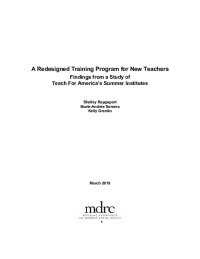A Redesigned Training Program for New Teachers
Findings from a Study of Teach For America’s Summer Institutes

In summer 2015, roughly six years after the Great Recession of 2007-2009 ended, the American
media began reporting on an emerging teacher shortage. Public schools were reinstating programs and classes that they had cut during the recession, and student enrollment was increasing. Meanwhile, enrollment in teacher training programs was decreasing. Teacher shortages are especially problematic for schools serving mainly students from low-income families and communities of color.
Teach For America (TFA), founded in 1989, has grown to become one of the largest providers of educators in the country for high-needs, underresourced schools. TFA recruits high-performing college graduates and professionals and prepares them for teaching during five to seven weeks of intensive training at its regional and national summer “institutes” before their first teaching job. In 2015, TFA was awarded a Supporting Effective Educator Development (SEED) grant from the U.S. Department of Education to redesign its summer training for new teachers, or “corps members” (CMs). In summer 2016, TFA piloted a redesigned training model, developed specifically for adult learners, that incorporated more rigorous academic standards and training methods and practices with an eye toward college and career readiness. The new model differed substantially from TFA’s traditional training, most notably in the method of delivering training to CMs and the use of content-based instructional activities.
This report presents the findings from a study that examined how the redesigned training was implemented in a TFA training site (program group) and how it compared with the usual training at other TFA sites (comparison group). It also examined the promise of the redesigned training to improve the short-term outcomes of the first cohort of TFA teachers to receive it — that is, CMs’ use of the new instructional strategies and teaching practices, their perceptions of the value of the training, their commitment to teaching and to equity, and their retention rates in the TFA program. Not surprisingly, given the complexity of the new training, TFA encountered a number of implementation challenges:
-
It was more difficult to implement the redesigned training than anticipated, as it involved preparing TFA summer staff, in less than one year, to use radically different methods from those of TFA’s traditional training to teach corps members.
-
Lead instructors in the program group did not consistently or deliberatively model the new teaching strategies and practices, and as a result, no differences were found between CMs in the program group and the comparison group in their use of these new strategies and practices.
-
CMs in the program group did not have more positive perceptions of the value of their summer training than did those in the comparison group.
-
The redesigned training does not appear to have improved CMs’ commitment to teaching and educational equity, or to have improved their retention rates in the TFA program.
Although the hoped-for outcomes did not materialize, the first cohort of CMs who received the redesigned training performed no better or worse than CMs who received TFA’s usual training. The lessons from this study have helped TFA address the challenges that were encountered during implementation and to strengthen the redesigned training model. TFA has now revamped the model and in summer 2017 began to scale it up at their national institutes.






